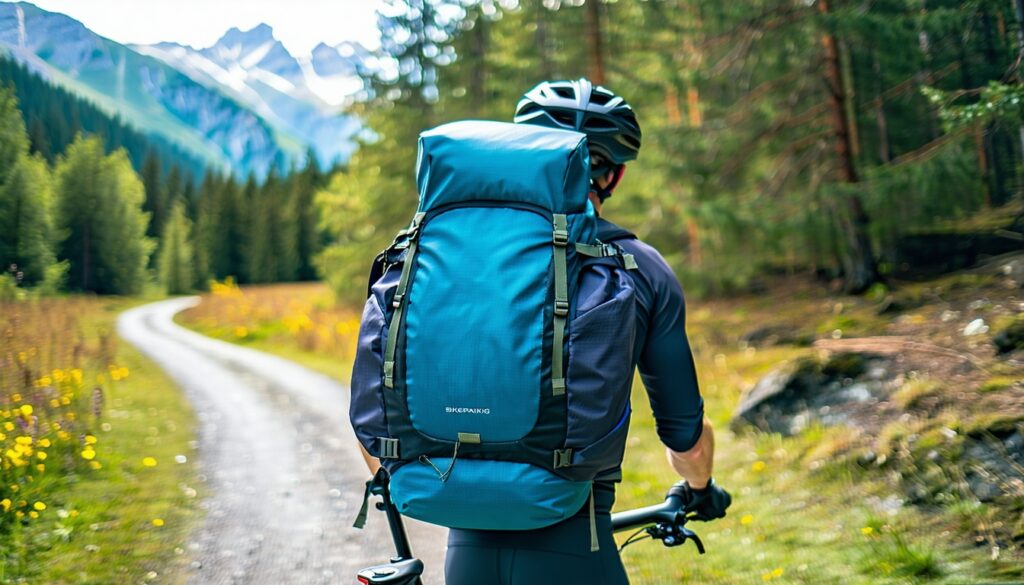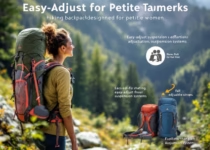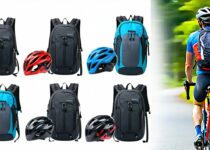Lightweight Bikepacking Backpacks for Short Trips

The Essentials of Bikepacking
When planning a bikepacking adventure, the type of gear storage is crucial for a successful trip. Three main types of packs are essential for this purpose: frame packs, seat packs, and handlebar packs. Each serves specific needs and contributes to an efficient bikepacking experience.
Frame Packs
Frame packs are designed to fit snugly in the triangle formed by the bike’s top tube, seat tube, and down tube, providing a great space for heavier items. Their capacity ranges from three to nine liters, depending on the size of the pack.
| Pack Size | Storage Capacity |
|---|---|
| Extra-Small Half-Frame Bag | 3 liters |
| Extra-Large Full-Frame Pack | 9 liters |
Using frame packs helps keep the bike’s center of gravity low, contributing to stable handling while riding. They are ideal for carrying heavier items like food, tools, spare parts, stove fuel, batteries, and water (REI).
Seat Packs
Seat packs are versatile and light, making them suitable for shorter trips. An excellent example is the Miss Grape Cluster 7, which offers a 7-liter capacity. This pack is designed for lighter, smaller loads and has been tested in stormy conditions, proving its durability.
Features of Miss Grape Cluster 7:
- Rubber straps prevent damage to the bike
- Roll-down top for water resistance
- Remains stable without sagging or rubbing against thighs while pedaling
Handlebar Packs
Handlebar packs offer a convenient way to store gear that is easily accessible while riding. They should be used for lighter items to maintain a balanced front load.
A great option for short trips is Restrap’s 10-liter Bar Pack, crafted from durable, waterproof nylon. This pack features:
- Roll-top closure
- Smaller secondary compartment for easy access
- Compression straps for added stability of the load
| Pack Type | Storage Capacity | Primary Use |
|---|---|---|
| Miss Grape Cluster 7 | 7 liters | Short trips, lighter loads |
| Restrap’s 10-liter Bar Pack | 10 liters | Convenient access, light items |
These essential bikepacking packs allow cyclists of any age to enjoy their adventures with proper gear management. Consider each pack’s unique benefits to maximize your efficiency on the road. For tips on how to make the most of your bikepacking journey, check out our article on using a cycling backpack for bikepacking weekend trips.
Choosing the Right Cycling Backpack
Selecting the perfect cycling backpack is essential for any cyclist, especially when considering lightweight bikepacking backpacks for short trips. There are many factors to think about, along with various types of backpacks to choose from.
Factors to Consider
When choosing a cycling backpack, it’s important to take several key features into account:
- Strap Design: Look for ergonomic straps that distribute weight evenly and provide comfort during rides.
- Adjustability: A backpack with adjustable straps allows for a personalized fit, reducing the risk of discomfort during long rides.
- Back Padding Contour: Proper lumbar support and padding contour help maintain comfort on the back during extended cycling.
- Temperature and Humidity: Choose materials that fare well in your specific climate conditions. Good wicking and breathable materials help keep you comfortable.
- Storage Capacity: Most backpacks come with a hydration sleeve, reducing space for other items. Some cyclists prefer to carry water in cages, allowing them to use the pack for bulky items like sleeping pads or clothing.
| Factor | Importance Description |
|---|---|
| Strap Design | Ensures comfort and weight distribution |
| Adjustability | Provides a personalized fit |
| Back Padding Contour | Maintains lumbar support during rides |
| Climate Compatibility | Materials should suit local temperature and humidity conditions |
| Storage Capacity | Balances hydration needs with space for other gear |
Types of Backpacks
Cycling backpacks come in different styles, each designed to suit various riding preferences:
-
Traditional Backpacks: These feature a vertical orientation that spreads out weight across the back and shoulders. They are common but may cause discomfort if loaded heavily.
-
Lowrider Packs: This style shifts the weight from the back to the hips, lowering the center of gravity. Many cyclists find these more comfortable, especially on longer trips. They often provide better balance and stability.
Choosing between these types often depends on personal preference and comfort. Testing different packs before purchasing is recommended to find the most suitable option for one’s specific needs. For some cyclists, functionality like hydro compatibility or having reflective features that improve cycling visibility might also influence their decision.
Lightweight Bikepacking Backpack Recommendations
When it comes to lightweight bikepacking, choosing the right backpack is essential for a comfortable and enjoyable ride. Here are two highly recommended options that excel in functionality and design for short trips.
Miss Grape Cluster 7
The Miss Grape Cluster 7 is considered one of the best lightweight bikepacking bags for shorter trips. With a capacity of 7 liters, it’s perfect for lighter, smaller loads. This seat pack is especially useful for those with limited exposed seat posts and has been tested under stormy conditions for reliability.
Key Features:
| Feature | Description |
|---|---|
| Capacity | 7 liters |
| Design | Roll-down top for water resistance |
| Stability | Remains stable without sagging or rubbing against thighs |
| Additional Capacity | Webbing loops for extra items |
| Durability | Proven performance in storms and on long rides |
The Miss Grape Cluster 7’s robust design includes rubber straps to prevent damage to the bike, making it a reliable choice for bikepacking adventures.
Restrap’s 10-liter Bar Pack
Another great option for short trips is Restrap’s 10-liter Bar Pack. Constructed from durable, waterproof nylon, this lightweight handlebar bag is perfect for cyclists looking for convenience and functionality on the go. Its roll-top closure helps keep contents secure and dry, while a smaller secondary compartment allows for easy access to frequently needed items.
Key Features:
| Feature | Description |
|---|---|
| Capacity | 10 liters |
| Closure Type | Roll-top for weather protection |
| Access | Secondary compartment for quick access |
| Compression Straps | Helps keep items secured during rides |
| Material | Durable and waterproof nylon |
The Restrap Bar Pack’s well-thought-out design and compression straps ensure that your gear remains in place, even on bumpy trails.
Both the Miss Grape Cluster 7 and Restrap’s 10-liter Bar Pack are highly recommended for lightweight bikepacking adventures. They cater to the needs of cyclists looking for practicality and comfort during short trips.
Backpacks vs. Traditional Bikepacking Bags
When planning a bikepacking adventure, cyclists often face the decision between using backpacks and traditional bikepacking bags. Each option has its pros and cons, which can significantly impact the overall experience.
Advantages of Backpacks
Backpacks offer several benefits that appeal to many cyclists. They provide a practical way to keep important items close at hand and offer weight advantages during challenging sections of the ride, such as hike-a-bikes. Backpacks are particularly advantageous for carrying fragile items like cameras, giving them better protection compared to traditional bikepacking bags. They also allow for easy access to moveable items during off-bike exploration, making them versatile for various activities.
Key Benefits of Backpacks
| Advantage | Description |
|---|---|
| Ease of Access | Keeps items close and easily reachable. |
| Weight Distribution | Improves balance and handling during difficult rides. |
| Protection for Gear | Offers extra cushioning for delicate items. |
| Versatility | Functions well for off-the-bike activities and exploration. |
Disadvantages of Backpacks
Despite their benefits, backpacks also come with certain drawbacks. Comfort is a crucial factor, especially when carrying significant loads of food or water. Traditional vertical orientation backpacks may shift weight to the shoulders, which might lead to discomfort on longer rides. Some cyclists may find “lowrider” packs more comfortable, as they move the weight to the hips, lowering the center of gravity. Testing different options is advisable to find the best fit, as preferences can vary widely among riders.
Key Drawbacks of Backpacks
| Disadvantage | Description |
|---|---|
| Comfort Concerns | Longer rides may lead to shoulder or back fatigue. |
| Limited Capacity | May not hold as much as larger bikepacking bags. |
| Weight on Back | Can cause overheating or difficulty balancing weight. |
Considering these advantages and disadvantages can help cyclists make an informed decision about gear choice for their next trip. Factors such as strap design, adjustability, and additional features are crucial to observe when selecting the right backpack for lightweight bikepacking backpacks for short trips.
Best Cycling Backpacks for Commuters
When looking for the best cycling backpacks for commuting, comfort, durability, and weather resistance should be top of mind. Here are four excellent options that blend functionality and style.
CamelBak MULE Commute 22
The CamelBak MULE Commute 22 backpack is perfect for commuters seeking a lightweight and stylish solution. This weather-resistant option features a roll-top sleeve that can accommodate a laptop or A4-sized notebook. Additionally, it offers multiple pockets, including:
| Pocket Type | Description |
|---|---|
| Zipped Mesh Pocket | For secure storage of small items |
| Arm Harness Pockets | Ideal for keys and a phone |
| Side Pockets | Designed to hold a D-lock |
The backpack also incorporates an air channel back for ventilation, making it comfortable for longer rides.
Rapha Travel Backpack
For those who prioritize style alongside functionality, the Rapha Travel Backpack is a great choice. It boasts a capacity of 25 liters and features a waterproof nylon exterior complemented by reflective elements for better visibility. Key features include:
| Feature | Description |
|---|---|
| Main Body Compartment | Includes a fabric splitter for organization |
| Padded Laptop Pocket | Protects your device during commutes |
| Easy Adjustable Straps | Provides comfort for extended wear |
While this option is on the pricier side, its well-padded straps and reflective coating offer excellent value for daily cycling and travel.
Camelbak HAWG Commute 30L
The Camelbak HAWG Commute 30L is designed for cyclists who need a little more capacity. It offers multiple pockets, a weatherproof sleeve, and reflective areas to enhance safety while riding. Features include:
| Feature | Description |
|---|---|
| Capacity | 30 liters |
| Stable Harness System | Keeps the backpack securely in place |
| Airflow Design | Ensures comfort during rides |
Though users may find it a bit heavier than expected, it remains a reliable option for those needing additional storage space.
Ortlieb’s Commuter Daypack Urban Line
The Ortlieb Commuter Daypack Urban Line stands out for its exceptional waterproof construction and comfort. This 27-liter backpack is built for urban riders looking for high-quality protection. Noteworthy features include:
| Feature | Description |
|---|---|
| Padded Device Pocket | Safely stores laptops or tablets |
| Spacious Main Compartment | Accommodates daily essentials |
| Durability | Designed to withstand urban environments |
Whether navigating city streets or biking in inclement weather, this backpack provides unparalleled protection for your belongings.
Each of these lightweight bikepacking backpacks for short trips meets the needs of commuters, blending comfort, function, and style for the everyday cyclist. For more tips on choosing the right cycling backpack, refer to our guide on how to choose an ergonomic cycling backpack for comfort and posture.
Specific Cycling Backpack Reviews
Exploring various cycling backpacks can help cyclists make informed choices based on their riding preferences and needs. Here are some standout options in the category of lightweight bikepacking backpacks for short trips.
Osprey Raptor 10 and Raven 10
The Osprey Raptor 10 and the women’s specific Raven 10 are highly versatile mountain bike backpacks. With a capacity of 10 liters, they include 10 zippered and stretch pockets for effective organization. Each pack also features a 2.5-liter Hydraulics LT reservoir for hydration. Constructed with durable 210-denier nylon and equipped with wide shoulder straps for optimal weight distribution, these backpacks retail for approximately $165.
| Feature | Osprey Raptor 10 / Raven 10 |
|---|---|
| Capacity | 10 liters |
| Reservoir | 2.5 liters |
| Material | 210-denier nylon |
| Price | $165 |
Osprey Katari 7
The Osprey Katari 7 is an affordable choice at $90, appealing to those needing ample hydration without excessive gear. It features the same 2.5L Hydraulics LT reservoir and is designed for minimalists during long rides. Testers noted the lack of structure, which may cause weight to rest heavily on the shoulders rather than being distributed to the hips.
| Feature | Osprey Katari 7 |
|---|---|
| Capacity | 7 liters |
| Reservoir | 2.5 liters |
| Price | $90 |
Dakine Seeker 6L
The Dakine Seeker 6L is a compact waist pack with a 6L capacity, tailored for short rides and quick outings. It includes a 2-liter HydraPak reservoir and has a well-organized storage layout. Although its design may divide opinions, it serves minimalists well who prefer not carrying extensive gear or hydration.
| Feature | Dakine Seeker 6L |
|---|---|
| Capacity | 6 liters |
| Reservoir | 2 liters |
| Price | $80 (approx.) |
Patagonia Dirt Roamer 20L
For cyclists seeking more storage, the Patagonia Dirt Roamer 20L offers generous space with a 20-liter capacity. This pack utilizes vertically oriented zippers for easy access and separates the water reservoir from the main compartment. While it excels in storage and organization with elastic loops and internal pockets, it may compromise back ventilation compared to other models.
| Feature | Patagonia Dirt Roamer 20L |
|---|---|
| Capacity | 20 liters |
| Reservoir Storage | Separate sleeves |
| Price | $199 (approx.) |
Evoc Trail Pro 10
The Evoc Trail Pro 10 is designed for serious mountain bikers, featuring capacities ranging from 10L to 26L. It includes built-in spine protection to safeguard against impacts, making it invaluable for riders who take on rugged trails. Comfortable hip straps and stretchy Velcro straps enhance adjustability, although it does not include a water reservoir and is priced around $240.
| Feature | Evoc Trail Pro 10 |
|---|---|
| Capacity | 10, 16, or 26 liters |
| Spine Protection | Yes |
| Price | $240 |
These backpacks provide various features catering to different cycling styles, helping cyclists find the right fit for their adventures. For more tips on selecting a suitable pack, check out our article on how to choose an ergonomic cycling backpack for comfort and posture.


